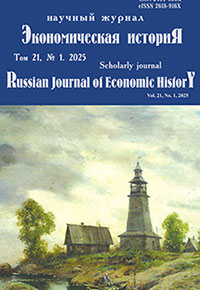Экономическая историЯ
Russian Journal of Economic History
ISSN 2409-630X (Print)
ISSN 2618-916X (Online)
Expert board:
- Scientific Council of RAS on economic history;
- Research and Educational Center «The economic history of Central Russia and the Middle Volga region» of Ogarev Mordovia State University;
- Center of Economic History of Lomonosov Moscow State University
Navigation
Аndrei V. Keller
Ural Federal University (Ekaterinburg, Russia),
e-mail: keller26000@gmail.com
Small Manufacturing Networks as a Factor of Technological Leadership
Abstract
Introduction. The study of the structure of scientific knowledge during the early modern period and the analysis of the causes and consequences of the Great Divergence are crucial for understanding the convergence of the “arts and sciences” (as seen in the Scientific Revolution). This convergence was a transformative process that reshaped economic, scientific, social, and technological landscapes. This research not only sheds light on historical developments but also provides insights into contemporary challenges, such as enhancing human potential and achieving technological leadership.
Materials and Methods. To explore these themes, the study employs a combination of comparative historical, chronological, and genealogical research methods. These approaches allow for a nuanced analysis of the evolution of scientific and artistic practices, as well as their socio-economic impacts.
Results. The study builds on the author’s 2018 model of small manufacturing networks, which serves as a foundational framework for understanding the role of crafts in the history of economic theory. This model highlights crafts as a significant yet often overlooked player in the economy, capable of driving innovation and economic growth. By applying this model, the study identifies crafts as a vital component of economic development, particularly in the context of early Modern Russia.
Discussion and Conclusion. The establishment of new institutions during the early Modern period, such as craft guilds in 1722 and the Academy of Arts and Sciences in 1724, played a pivotal role in shaping the social, scientific, and technological landscape. These institutions not only fostered the emergence of new crafts but also facilitated the development and dissemination of new technologies. The integration of the Academy of Sciences with craft workshops contributed to the creation of new craft professions, which in turn supported economic diversification and technological advancement. This synergy between the arts and sciences underscores the importance of interdisciplinary approaches in driving long-term economic and technological development.
Keywords: economic history, sustainable development, small manufacturing networks, catch-up modernization, innovative economy, human capital, Great Divergence, Scientific Revolution, Saint Petersburg Academy of Arts and Sciences, technologies.
For citation: Keller A. V. Small Manufacturing Networks as a Factor of Technological Leadership. Economicheskaya istoriya = Russian Journal of Economic History. 2025; 21(1): 9–19. (In Russ.). DOI: 10.24412/2409-630X.068.021.202501.009-019.
Acknowledgements: The research was carried out with supported as part of the implementation of the state task of the Ministry of Science and Higher Education of the Russian Federation according to the research project No. FEUZ 2023-0018.
© Ogarev Mordovia State University. History and Sociology Institute, 2017
68, Of. 411, Bolshevistskaya St., 430005, The editorial office of the scholarly journal «Russian Journal of Economic History»
Tel.: (8342) 24-25-90; 27-07-11, Fax: (8342) 24-25-90, E-mail: jurnal-econom-hist@isi.mrsu.ru
Designed by A. Napalkov, Email: napalkov@isi.mrsu.ru


